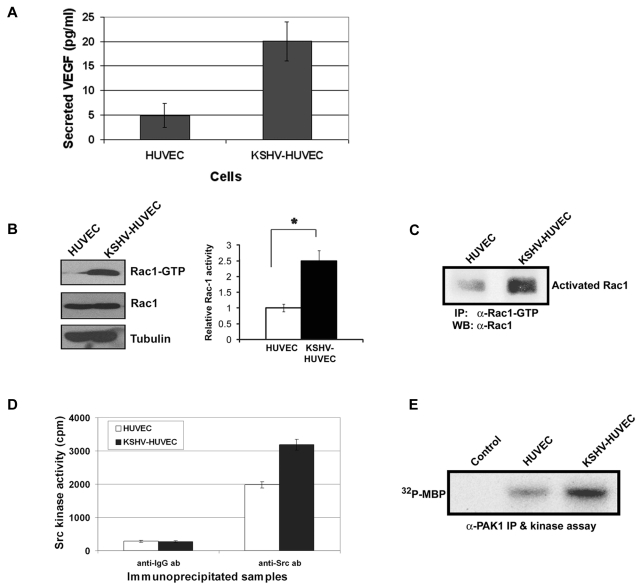Figure 1.
Rac1 is activated in KSHV-infected endothelial cells. (A) The amount of VEGF secreted from uninfected HUVEC and KSHV-infected HUVEC was determined by Luminex assay (Millipore). Four individual replicates were performed and the error bars represent the SD. (B) Detection of activated Rac1 in HUVEC and KSHV-HUVEC. HUVEC and KSHV-HUVEC were harvested, lysed, and activated Rac1 (Rac1-GTP) was immunoprecipitated with GST-PBD and analyzed by Western blot analysis. Corresponding densitometric analysis of Rac1-GTP normalized to Rac1 levels was performed, and this is shown as relative Rac1 activity in the HUVEC. Values are presented as the mean ± SD of 5 independent experiments. *P < .05; n = 5. (C) HUVEC and KSHV-HUVEC were grown to confluence and the cell lysates were immunoprecipitated with anti–Rac1-GTP antibody. The immunoprecipitates were subjected to Western blot analysis with anti-Rac1 antibody. The level of activated Rac1 in KSHV-HUVEC was higher than that in HUVEC. (D) Increased Src kinase activity was observed in KSHV HUVEC compared with HUVEC. Cell lysates from both cells were immunoprecipitated with anti-Src antibody (clone GD11; Millipore). Src kinase assays were performed as per the manufacturer's instructions. Anti-Src immunoprecipitations were used in a kinase assay with the KVEKIGEGTYGVVYK peptide as substrate. Immunoprecipitated complexes with normal mouse IgG were used as the negative control. Phosphorylated peptide was quantitated using a scintillation counter. Values are presented as the mean ± SD of 4 independent experiments. (E) Increased PAK1 kinase activity was seen in KSHV-HUVEC compared with HUVEC.PAK1 immunoprecipitated from cell lysates were used in the kinase assays, along with MBP as the PAK1 substrate. Samples were subjected to SDS-PAGE. 32P-labeled MBP was visualized by autoradiography.

